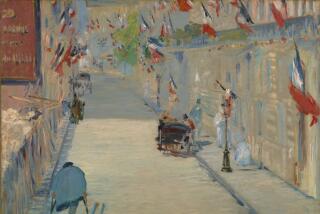From Cover to Cover
- Share via
A major exhibition on a minor scale is on view at Pasadena’s Art Center College of Design. “Czech Avant-Garde: Reflections on European Art and Photography, 1922-1940” contains about 500 examples of books and book design representing the recovery of a lost chapter in the history of radical modernist art.
According to Williamson Gallery director Steven Nowlin, this startling bit of cultural archeology is the work of Czech-German art historian Zdenk Primus, who is also the traveling exhibition’s curator. Despite censorship by the Nazis and the eventual destruction of many volumes from the Nazi years, Primus has managed to unearth a total of nearly 800 books that help define modernism in Eastern Europe.
For all but the best-informed Americans, the history of modern art in Eastern Europe is terra incognita. And Czechoslovakia is a mystery within an enigma. It didn’t even exist before the end of World War I, when it was cobbled together by the Allies out of pieces of the old Austro-Hungarian Empire. Young intellectuals of the new nation were energized by the kind of utopian ideals that also animated the Russian avant-garde: Art could change the world. Art would no longer be an exclusive precinct of the rich. Art was for the people.
What better way to express this than through inexpensive books on smart subjects designed by the best artists the new nation could muster? The idea grew into a hallmark of Eastern European modernism. Before it was sucked into the communist orbit, the region was noted for an unusually high level of integration between all the arts. The designers of these books came from the freshly formed artist’s union, producing such self-evident masters as the chef-d’ecole Karel Teige, Frantisek Musika, Ladislav Sutnar and a healthy list of others.
Brought back from obscurity by Primus, they offer today’s viewers art with a level of energy, inventiveness and idealism easily on par with better-known Russian counterparts like Alexandr Rodchenko and El Lissitzky. There is no reason to assume that inspiration always ran from Moscow to Prague.
The Czech work reflects a sophisticated understanding of all the influences then current. We see books with the floating geometric forms of Constructivism in its trademark cheap-to-print black, white and red. There is the playfulness of photo-montage in the accents of Dada and Surrealism. A particularly risible example is an unusual tabloid format rendition of the alphabet by Teige where a pretty girl mimes the letters.
The Czechs seem to have invented some “isms” of their own. I at least had never run across such movements as “Artificialism” or “Poetism” or heard the wonderful 1922 pun coined by artist Ilya Ehrenberg “Art Siezes to Be Art.”
This exhibition is animated by that engaging combination of the frisky and the earnest that is always a sign of youth and hope. There are volumes devoted to Charlie Chaplin, George Bernard Shaw, Josephine Baker and Andre Breton. Still-familiar graphic symbols like hand prints, eyes and arrows abound. Jazz is just as important as psychoanalysis and pulp fiction reigns with Marxism.
The exhibition seems in some ways distant and esoteric, in others familiar and nostalgic. After World War II, L.A. formed a scruffy avant-garde around the ideals of the Beat Generation. There were coffeehouses like the Blue Couch on Fairfax, bohemian bookstores like Chatterton’s on Vermont and foreign film emporiums like the Vagabond and the Coronet. Like the Czechs we thought of our paperback covers as artworks.
Today Prague is once again an international Left Bank. There are lots of good reasons to see this exhibition. Anybody who wants a preview can call one up on that other new populist underground, the Internet. The code is https://www.artcenter.edu/exhibit/williamson.html
BE THERE
“Czech Avant-Garde: Reflections on European Art and Photography, 1922-1940,” Art Center College of Design, Alyce de Roulet Williamson Gallery, 1700 Lida St., Pasadena; through April 27, closed Mondays and holidays. (818) 396-2244.
More to Read
The biggest entertainment stories
Get our big stories about Hollywood, film, television, music, arts, culture and more right in your inbox as soon as they publish.
You may occasionally receive promotional content from the Los Angeles Times.










